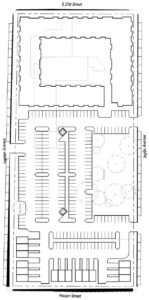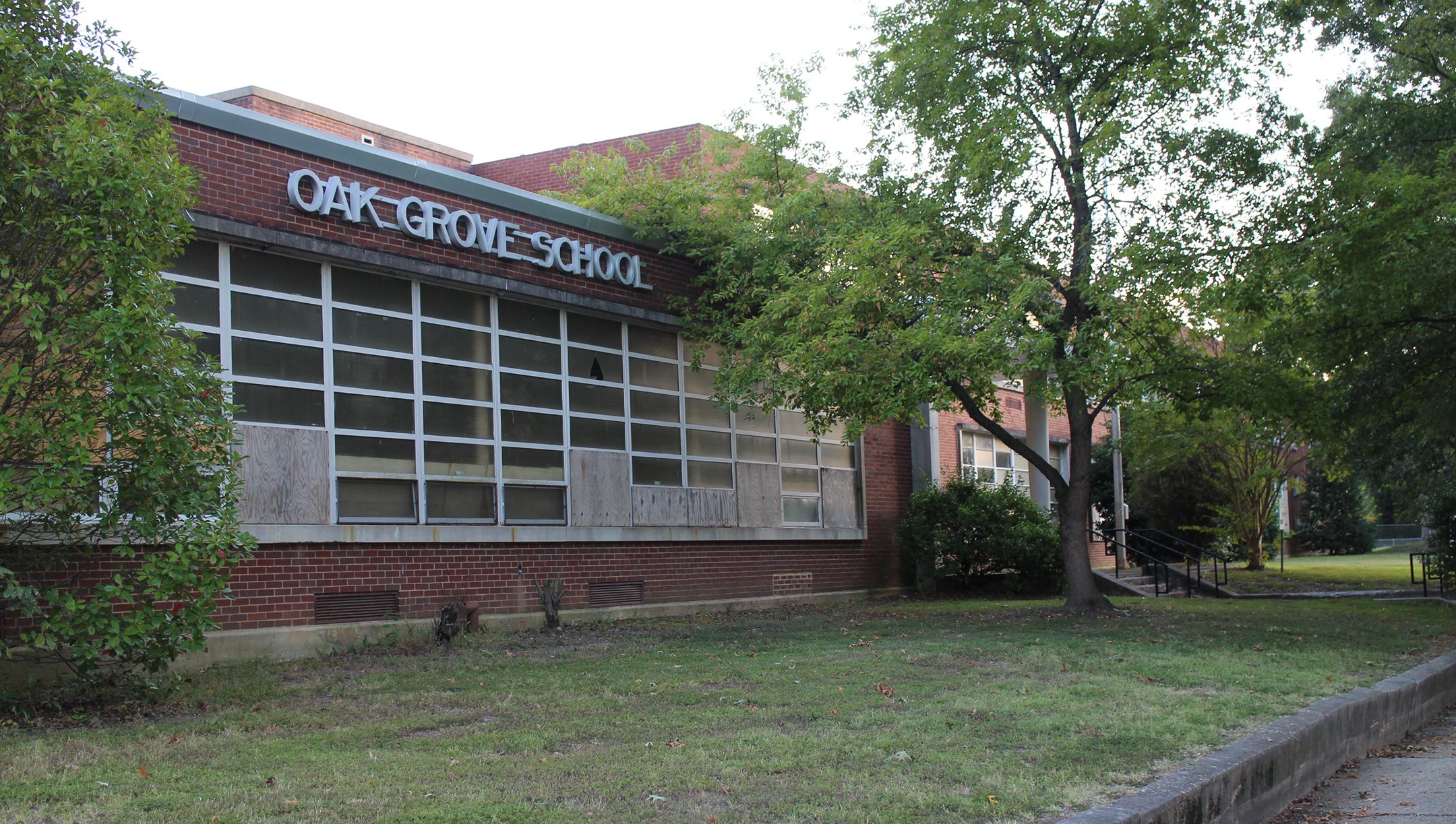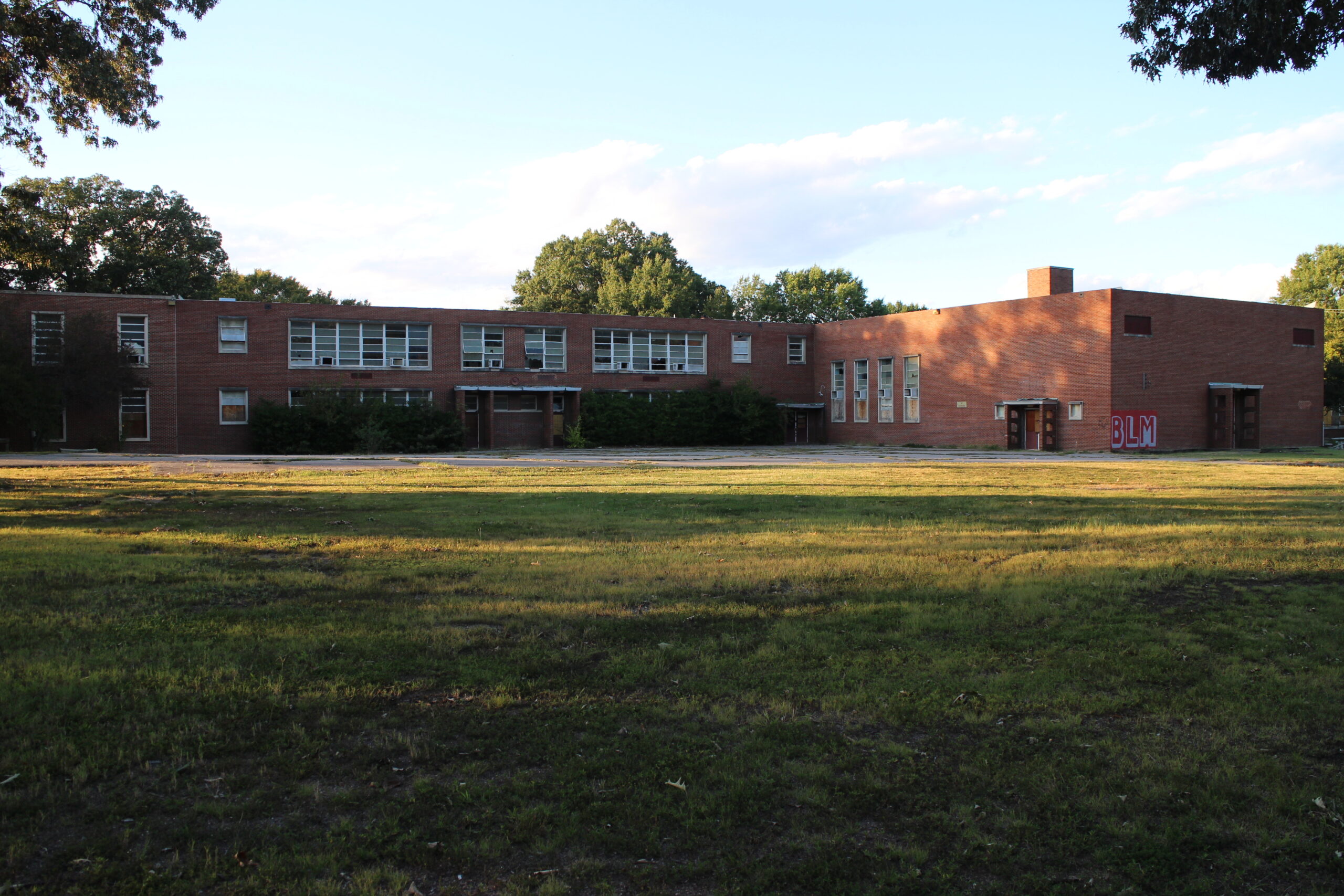A shuttered elementary school in Richmond’s Southside is set to make way for hundreds of income-based homes through a collaboration between a local developer and a housing nonprofit.
Lynx Ventures and the Maggie Walker Community Land Trust are planning a 255-unit, $45 million residential development on the site of the old Oak Grove Elementary School at 2200 Ingram Ave.
They’ve reached an agreement with the city to pay $500,000 for the surplus property, which the city positioned for sale last year as part of its biennial real estate disposition plan. The 5-acre property, a few blocks east of Route 1 from the Model Tobacco Lofts, is assessed by the city at $2.5 million.
Lynx and MWCLT submitted an unsolicited offer for the property, which also attracted a lower bid from a nearby church, according to a report from the Richmond Free Press. The City Council approved the sale to Lynx and MWCLT at its meeting last week.
Plans call for the school structure to be razed to make way for 240 apartments, to be developed by Lynx Ventures, and 15 for-sale townhomes or condos, which MWCLT would take on. Designs for the project are in the early stage, said Lynx Principal Bernard Harkless.
Harkless said the site came to Lynx’s attention through its work on Hatch Kitchen RVA and Clopton Siteworks in the area.
“We’ve always been keeping an eye on things in the neighborhood and had seen the building as rundown and outdated, and we saw an opportunity to bring some mixed-income housing to the neighborhood,” Harkless said.
The project is Lynx’s first collaboration with MWCLT, which Harkless said was brought on to handle the for-sale housing product, as Lynx focuses mainly on multifamily development.
The mix of one-, two- and three-bedroom apartments would be restricted for 30 years for rent to households earning 60 percent or less of the area median income, or between $35,000 and $65,000 a year depending on household size. At today’s numbers, the monthly rents would come out to $950 for a one-bedroom unit, $1,150 for a two-bedroom and $1,350 for a three-bedroom.

A mixed-income residential development is planned for the site of the old Oak Grove Elementary School, which would be razed. (Image courtesy of the City of Richmond)
The townhomes or condos would be priced between 40 and 80 percent AMI, or $40,000 to $80,000 a year in annual income for a family of four.

A conceptual layout shows the apartment building and the for-sale units separated by a parking lot and greenspace. (Image courtesy of Lynx Ventures)
Amenities for the apartments would include a pool, fitness center, stone countertops, in-unit washers and dryers, and electric vehicle charging stations.
About $20 million of the project cost would be leveraged through state and federal low-income housing tax credits.
In its proposal to the city, the group said it had determined that salvaging the school structure would cost an amount that would make the project unfeasible. The school was closed in 2014, and the group cites neglect since that time as a reason that rehabbing the structure would be cost prohibitive.
While the school building would not be saved, the group says it would incorporate Oak Grove’s legacy into the new project.
Baskervill is the architect and VHB is handling civil engineering. Hirschler attorney Brian Jackson is representing the group in its negotiations with the city.
Harkless said rezoning and special-use permit approvals would be needed after the sale, a process he expected to take about nine months. Final development approval would come from the City Council.
Demolition and construction are anticipated in late 2023, Harkless said. He said construction would likely take 18 to 20 months to complete.
The city’s real estate disposition plan calls for 36 other properties of the 77 positioned for sale last year to be conveyed to MWCLT for the Richmond Land Bank, which the nonprofit manages. An additional 15 parcels of city-owned real estate across the city were sold to the land trust last year.
A shuttered elementary school in Richmond’s Southside is set to make way for hundreds of income-based homes through a collaboration between a local developer and a housing nonprofit.
Lynx Ventures and the Maggie Walker Community Land Trust are planning a 255-unit, $45 million residential development on the site of the old Oak Grove Elementary School at 2200 Ingram Ave.
They’ve reached an agreement with the city to pay $500,000 for the surplus property, which the city positioned for sale last year as part of its biennial real estate disposition plan. The 5-acre property, a few blocks east of Route 1 from the Model Tobacco Lofts, is assessed by the city at $2.5 million.
Lynx and MWCLT submitted an unsolicited offer for the property, which also attracted a lower bid from a nearby church, according to a report from the Richmond Free Press. The City Council approved the sale to Lynx and MWCLT at its meeting last week.
Plans call for the school structure to be razed to make way for 240 apartments, to be developed by Lynx Ventures, and 15 for-sale townhomes or condos, which MWCLT would take on. Designs for the project are in the early stage, said Lynx Principal Bernard Harkless.
Harkless said the site came to Lynx’s attention through its work on Hatch Kitchen RVA and Clopton Siteworks in the area.
“We’ve always been keeping an eye on things in the neighborhood and had seen the building as rundown and outdated, and we saw an opportunity to bring some mixed-income housing to the neighborhood,” Harkless said.
The project is Lynx’s first collaboration with MWCLT, which Harkless said was brought on to handle the for-sale housing product, as Lynx focuses mainly on multifamily development.
The mix of one-, two- and three-bedroom apartments would be restricted for 30 years for rent to households earning 60 percent or less of the area median income, or between $35,000 and $65,000 a year depending on household size. At today’s numbers, the monthly rents would come out to $950 for a one-bedroom unit, $1,150 for a two-bedroom and $1,350 for a three-bedroom.

A mixed-income residential development is planned for the site of the old Oak Grove Elementary School, which would be razed. (Image courtesy of the City of Richmond)
The townhomes or condos would be priced between 40 and 80 percent AMI, or $40,000 to $80,000 a year in annual income for a family of four.

A conceptual layout shows the apartment building and the for-sale units separated by a parking lot and greenspace. (Image courtesy of Lynx Ventures)
Amenities for the apartments would include a pool, fitness center, stone countertops, in-unit washers and dryers, and electric vehicle charging stations.
About $20 million of the project cost would be leveraged through state and federal low-income housing tax credits.
In its proposal to the city, the group said it had determined that salvaging the school structure would cost an amount that would make the project unfeasible. The school was closed in 2014, and the group cites neglect since that time as a reason that rehabbing the structure would be cost prohibitive.
While the school building would not be saved, the group says it would incorporate Oak Grove’s legacy into the new project.
Baskervill is the architect and VHB is handling civil engineering. Hirschler attorney Brian Jackson is representing the group in its negotiations with the city.
Harkless said rezoning and special-use permit approvals would be needed after the sale, a process he expected to take about nine months. Final development approval would come from the City Council.
Demolition and construction are anticipated in late 2023, Harkless said. He said construction would likely take 18 to 20 months to complete.
The city’s real estate disposition plan calls for 36 other properties of the 77 positioned for sale last year to be conveyed to MWCLT for the Richmond Land Bank, which the nonprofit manages. An additional 15 parcels of city-owned real estate across the city were sold to the land trust last year.






This school was closed 10 years ago. Why has it taken so long for this surplus property to be sold? How many other “surplus” properties does the City of Richmond own, that could be sold?
It was closed, but not deemed “surplus” until last year. My guess is it had something to do with a determination by schools that they did not need it anymore. With the way they go through school administrations I am not surprised this fell through the cracks. They are usually trying to play whack a mole with all the other problems so they likely overlooked a closed school. Someone from the City should be keeping track of all that. Based on them surplussing over 70 properties last year sounds like someone is now doing that.
More affordable housing in south side sounds great. I certainly hope the site plan will be revised. Restoring the grid would be a good starting point. Minimizing the dominance of parking would be another (does each townhome need direct access or can they share a lot?)
Why did the city sell a $2.5 million property for $500,000? How does that work out?
Janie, I had the same thought??!